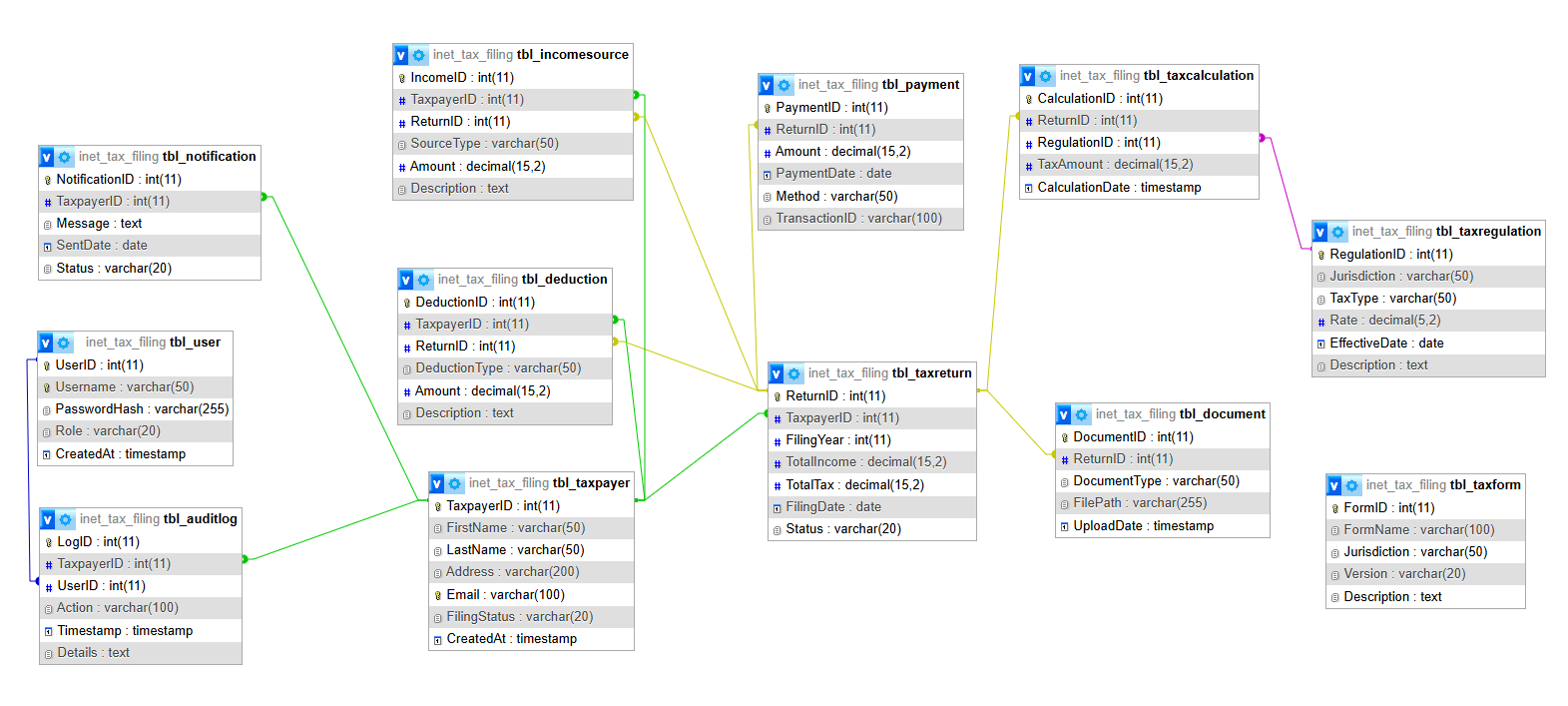Tax Filing and Compliance Automation System Database Design
Introduction to Tax Filing and Compliance Automation System Database Design
Table of Contents
- Introduction to Tax Filing and Compliance Automation System Database Design
- Importance and Benefits of Database Design for Tax Filing and Compliance Automation
- Steps in Planning the Database for Tax Filing and Compliance Automation
- Database Design: List of Tables for Tax Filing and Compliance Automation
- SQL Create Statements
- Example Queries for Tax Filing and Compliance Automation
- Summary and Conclusion
In today’s fast-paced business environment, managing tax filing and compliance manually is a daunting task prone to errors, missed deadlines, and inefficiencies. A Tax Filing and Compliance Automation System addresses these challenges by streamlining tax calculations, document submissions, and regulatory compliance processes. This system is a game-changer for businesses, accounting firms, and individual taxpayers who need to navigate complex tax laws while ensuring accuracy and timeliness. By leveraging a well-designed database, the system organizes critical data, automates repetitive tasks, and ensures adherence to ever-changing tax regulations.
The real-world problem this system solves is the overwhelming complexity of tax management. Businesses, especially small to medium-sized enterprises (SMEs), often struggle with tracking deductions, filing deadlines, and compliance with local, state, or federal tax laws. Manual processes lead to errors, penalties, and wasted time. A tax automation system simplifies these tasks by centralizing data, generating reports, and integrating with government portals for seamless submissions. It’s a lifesaver for target users like accountants, tax professionals, financial officers, and SMEs, as well as larger organizations with complex tax structures.
This blog post aims to guide readers through the process of designing a robust database for a Tax Filing and Compliance Automation System. You’ll learn how to structure the database to ensure efficiency, scalability, and compliance with data security standards. We’ll cover the importance of database design, the step-by-step planning process, a detailed schema with table descriptions, and practical SQL queries to demonstrate real-world functionality. Whether you’re a database administrator, developer, or business owner exploring automation, this post will equip you with the knowledge to model a database that supports accurate tax calculations, secure data storage, and seamless compliance workflows. By the end, you’ll understand how to translate system requirements into a functional database schema and apply these principles to similar automation projects.
Expect a clear breakdown of the database design process, complete with actionable steps and examples tailored to tax automation. We’ll also provide SQL code to create the database and sample queries to showcase its capabilities. This post is designed to be beginner-friendly yet comprehensive, making it accessible for those new to database design while offering insights for seasoned professionals.
Importance and Benefits of Database Design for Tax Filing and Compliance Automation
A well-structured database is the backbone of any Tax Filing and Compliance Automation System. It ensures data integrity, scalability, performance, and maintainability, which are critical for handling sensitive financial data and meeting regulatory requirements. Without a solid database design, the system risks errors, inefficiencies, and scalability issues that could lead to costly penalties or operational bottlenecks.
Efficiency in operations is a key benefit. A properly designed database organizes tax-related data—such as taxpayer profiles, income records, deductions, and filing statuses—into structured tables. This allows the system to quickly retrieve and process data for calculations, report generation, or submissions. For example, querying a well-indexed database can instantly fetch a taxpayer’s filing history, reducing processing time compared to scattered or poorly organized data.
Avoiding data redundancy is another critical advantage. Without proper design, duplicate records (e.g., multiple entries for the same taxpayer) can lead to inconsistent calculations or compliance errors. Normalization techniques eliminate redundancy by structuring data logically, ensuring each piece of information is stored once and referenced as needed. This reduces storage costs and simplifies updates, such as when tax rates change.
Supporting future system growth is essential for tax systems, as regulations evolve and businesses scale. A scalable database accommodates increasing data volumes, new tax types, or additional users without performance degradation. For instance, adding support for international tax laws requires flexible schemas that can incorporate new tables or fields without disrupting existing functionality.
Enabling secure and reliable access is paramount, given the sensitive nature of tax data. A well-designed database incorporates access controls, encryption, and audit trails to protect against unauthorized access or data breaches. It also ensures data consistency, preventing issues like incomplete filings or mismatched records that could trigger audits.
Without a robust database, the system faces challenges like slow query performance, data inconsistencies, or inability to adapt to new regulations. For example, a poorly designed database might struggle to handle concurrent users during tax season, leading to system crashes. Similarly, lack of normalization could cause errors in tax calculations, resulting in penalties. By prioritizing database design, organizations ensure their tax automation system is efficient, compliant, and future-proof, ultimately saving time and reducing risk.
Steps in Planning the Database for Tax Filing and Compliance Automation
Designing a database for a Tax Filing and Compliance Automation System requires a structured approach to translate system requirements into a functional schema. Below are the key steps, tailored to the system’s needs:
- Requirement Analysis: Understand the system’s goals, such as automating tax calculations, generating reports, and ensuring compliance. Identify user needs (e.g., accountants need quick access to filing histories) and regulatory requirements (e.g., data retention for audits). For example, the system must store taxpayer details, income sources, deductions, and filing deadlines.
- Entity and Attribute Identification: Define core entities like Taxpayers, Tax Returns, Income Sources, Deductions, and Tax Regulations. For each entity, list attributes—e.g., Taxpayer (ID, name, address, filing status) or Tax Return (return ID, filing year, total tax). This step ensures all necessary data points are captured.
- Relationship Mapping: Establish how entities connect. For instance, a Taxpayer has multiple Tax Returns, and each Tax Return links to Income Sources and Deductions. Use one-to-many or many-to-many relationships (e.g., Taxpayers to Tax Returns is one-to-many). This ensures the database reflects real-world interactions.
- Normalization: Apply normalization to eliminate redundancy and ensure data integrity. For example, separate Taxpayer details into a dedicated table to avoid duplicating names or addresses across Tax Returns. Normalize to at least the third normal form (3NF) to minimize anomalies during data updates or queries.
- Drafting an ER Diagram: Create an Entity-Relationship (ER) Diagram to visualize tables, attributes, and relationships. For example, the diagram shows Taxpayer linked to Tax Return via a foreign key (TaxpayerID). This serves as a blueprint for developers and stakeholders.
- Validating with Stakeholders: Review the design with tax professionals, developers, and compliance officers to ensure it meets operational and regulatory needs. For instance, confirm that the schema supports audit trails or multi-jurisdiction tax calculations. Adjust based on feedback to finalize the design.
These steps ensure the database aligns with the system’s need for accurate tax processing, secure data storage, and scalability. For example, requirement analysis might reveal the need for a table to track tax law changes, while normalization prevents duplicate regulation entries. The ER Diagram provides a clear roadmap for implementation, ensuring all stakeholders are aligned.
Database Design: List of Tables for Tax Filing and Compliance Automation
Below is the database schema for the Tax Filing and Compliance Automation System, including 12 tables with descriptions, fields, and relationships. Each table uses the prefix `tbl_`.
- tbl_Taxpayer
– Description: Stores taxpayer information.
– Fields: `TaxpayerID` (INT, Primary Key), `FirstName` (VARCHAR), `LastName` (VARCHAR), `Address` (VARCHAR), `Email` (VARCHAR), `FilingStatus` (VARCHAR).
– Relationships: Links to `tbl_TaxReturn` via `TaxpayerID` (one-to-many).
- tbl_TaxReturn
– Description: Records tax return details.
– Fields: `ReturnID` (INT, Primary Key), `TaxpayerID` (INT, Foreign Key), `FilingYear` (INT), `TotalIncome` (DECIMAL), `TotalTax` (DECIMAL), `FilingDate` (DATE).
– Relationships: Links to `tbl_Taxpayer`, `tbl_IncomeSource`, `tbl_Deduction`.
- tbl_IncomeSource
– Description: Tracks income sources for tax calculations.
– Fields: `IncomeID` (INT, Primary Key), `TaxpayerID` (INT, Foreign Key), `SourceType` (VARCHAR), `Amount` (DECIMAL), `Description` (TEXT).
– Relationships: Links to `tbl_Taxpayer` and `tbl_TaxReturn`.
- tbl_Deduction
– Description: Stores deduction details.
– Fields: `DeductionID` (INT, Primary Key), `TaxpayerID` (INT, Foreign Key), `ReturnID` (INT, Foreign Key), `DeductionType` (VARCHAR), `Amount` (DECIMAL).
– Relationships: Links to `tbl_Taxpayer` and `tbl_TaxReturn`.
- tbl_TaxRegulation
– Description: Stores tax laws and rates.
– Fields: `RegulationID` (INT, Primary Key), `Jurisdiction` (VARCHAR), `TaxType` (VARCHAR), `Rate` (DECIMAL), `EffectiveDate` (DATE).
– Relationships: Links to `tbl_TaxCalculation`.
- tbl_TaxCalculation
– Description: Records tax calculation results.
– Fields: `CalculationID` (INT, Primary Key), `ReturnID` (INT, Foreign Key), `RegulationID` (INT, Foreign Key), `TaxAmount` (DECIMAL).
– Relationships: Links to `tbl_TaxReturn` and `tbl_TaxRegulation`.
- tbl_Payment
– Description: Tracks tax payments.
– Fields: `PaymentID` (INT, Primary Key), `ReturnID` (INT, Foreign Key), `Amount` (DECIMAL), `PaymentDate` (DATE), `Method` (VARCHAR).
– Relationships: Links to `tbl_TaxReturn`.
- tbl_Document
– Description: Stores submitted documents (e.g., W-2 forms).
– Fields: `DocumentID` (INT, Primary Key), `ReturnID` (INT, Foreign Key), `DocumentType` (VARCHAR), `FilePath` (VARCHAR).
– Relationships: Links to `tbl_TaxReturn`.
- tbl_AuditLog
– Description: Tracks system actions for compliance.
– Fields: `LogID` (INT, Primary Key), `TaxpayerID` (INT, Foreign Key), `Action` (VARCHAR), `Timestamp` (DATETIME).
– Relationships: Links to `tbl_Taxpayer`.
- tbl_User
– Description: Stores system user details.
– Fields: `UserID` (INT, Primary Key), `Username` (VARCHAR), `PasswordHash` (VARCHAR), `Role` (VARCHAR).
– Relationships: Links to `tbl_AuditLog` for user actions.
- tbl_TaxForm
– Description: Stores tax form templates.
– Fields: `FormID` (INT, Primary Key), `FormName` (VARCHAR), `Jurisdiction` (VARCHAR), `Version` (VARCHAR).
– Relationships: Links to `tbl_TaxReturn`.
- tbl_Notification
– Description: Tracks user notifications (e.g., filing deadlines).
– Fields: `NotificationID` (INT, Primary Key), `TaxpayerID` (INT, Foreign Key), `Message` (TEXT), `SentDate` (DATE).
– Relationships: Links to `tbl_Taxpayer`.

SQL Create Statements
-- Create the database
CREATE DATABASE IF NOT EXISTS inet_tax_filing;
USE inet_tax_filing;
-- Table: tbl_User
-- Stores system user details (created first due to tbl_AuditLog dependency)
CREATE TABLE tbl_User (
UserID INT PRIMARY KEY AUTO_INCREMENT,
Username VARCHAR(50) UNIQUE NOT NULL,
PasswordHash VARCHAR(255) NOT NULL,
Role VARCHAR(20) NOT NULL,
CreatedAt TIMESTAMP DEFAULT CURRENT_TIMESTAMP
);
-- Table: tbl_Taxpayer
-- Stores taxpayer information (created early due to dependencies)
CREATE TABLE tbl_Taxpayer (
TaxpayerID INT PRIMARY KEY AUTO_INCREMENT,
FirstName VARCHAR(50) NOT NULL,
LastName VARCHAR(50) NOT NULL,
Address VARCHAR(200),
Email VARCHAR(100) UNIQUE NOT NULL,
FilingStatus VARCHAR(20) NOT NULL,
CreatedAt TIMESTAMP DEFAULT CURRENT_TIMESTAMP
);
-- Table: tbl_TaxRegulation
-- Stores tax laws and rates (no dependencies)
CREATE TABLE tbl_TaxRegulation (
RegulationID INT PRIMARY KEY AUTO_INCREMENT,
Jurisdiction VARCHAR(50) NOT NULL,
TaxType VARCHAR(50) NOT NULL,
Rate DECIMAL(5,2) NOT NULL,
EffectiveDate DATE NOT NULL,
Description TEXT
);
-- Table: tbl_TaxForm
-- Stores tax form templates (no dependencies)
CREATE TABLE tbl_TaxForm (
FormID INT PRIMARY KEY AUTO_INCREMENT,
FormName VARCHAR(100) NOT NULL,
Jurisdiction VARCHAR(50) NOT NULL,
Version VARCHAR(20) NOT NULL,
Description TEXT
);
-- Table: tbl_TaxReturn
-- Records tax return details (depends on tbl_Taxpayer)
CREATE TABLE tbl_TaxReturn (
ReturnID INT PRIMARY KEY AUTO_INCREMENT,
TaxpayerID INT NOT NULL,
FilingYear INT NOT NULL,
TotalIncome DECIMAL(15,2) DEFAULT 0.00,
TotalTax DECIMAL(15,2) DEFAULT 0.00,
FilingDate DATE,
Status VARCHAR(20) DEFAULT 'Pending',
FOREIGN KEY (TaxpayerID) REFERENCES tbl_Taxpayer(TaxpayerID) ON DELETE CASCADE
);
-- Table: tbl_IncomeSource
-- Tracks income sources for tax calculations (depends on tbl_Taxpayer, tbl_TaxReturn)
CREATE TABLE tbl_IncomeSource (
IncomeID INT PRIMARY KEY AUTO_INCREMENT,
TaxpayerID INT NOT NULL,
ReturnID INT,
SourceType VARCHAR(50) NOT NULL,
Amount DECIMAL(15,2) NOT NULL,
Description TEXT,
FOREIGN KEY (TaxpayerID) REFERENCES tbl_Taxpayer(TaxpayerID) ON DELETE CASCADE,
FOREIGN KEY (ReturnID) REFERENCES tbl_TaxReturn(ReturnID) ON DELETE SET NULL
);
-- Table: tbl_Deduction
-- Stores deduction details (depends on tbl_Taxpayer, tbl_TaxReturn)
CREATE TABLE tbl_Deduction (
DeductionID INT PRIMARY KEY AUTO_INCREMENT,
TaxpayerID INT NOT NULL,
ReturnID INT,
DeductionType VARCHAR(50) NOT NULL,
Amount DECIMAL(15,2) NOT NULL,
Description TEXT,
FOREIGN KEY (TaxpayerID) REFERENCES tbl_Taxpayer(TaxpayerID) ON DELETE CASCADE,
FOREIGN KEY (ReturnID) REFERENCES tbl_TaxReturn(ReturnID) ON DELETE SET NULL
);
-- Table: tbl_TaxCalculation
-- Records tax calculation results (depends on tbl_TaxReturn, tbl_TaxRegulation)
CREATE TABLE tbl_TaxCalculation (
CalculationID INT PRIMARY KEY AUTO_INCREMENT,
ReturnID INT NOT NULL,
RegulationID INT NOT NULL,
TaxAmount DECIMAL(15,2) NOT NULL,
CalculationDate TIMESTAMP DEFAULT CURRENT_TIMESTAMP,
FOREIGN KEY (ReturnID) REFERENCES tbl_TaxReturn(ReturnID) ON DELETE CASCADE,
FOREIGN KEY (RegulationID) REFERENCES tbl_TaxRegulation(RegulationID) ON DELETE RESTRICT
);
-- Table: tbl_Payment
-- Tracks tax payments (depends on tbl_TaxReturn)
CREATE TABLE tbl_Payment (
PaymentID INT PRIMARY KEY AUTO_INCREMENT,
ReturnID INT NOT NULL,
Amount DECIMAL(15,2) NOT NULL,
PaymentDate DATE NOT NULL,
Method VARCHAR(50) NOT NULL,
TransactionID VARCHAR(100),
FOREIGN KEY (ReturnID) REFERENCES tbl_TaxReturn(ReturnID) ON DELETE CASCADE
);
-- Table: tbl_Document
-- Stores submitted documents (depends on tbl_TaxReturn)
CREATE TABLE tbl_Document (
DocumentID INT PRIMARY KEY AUTO_INCREMENT,
ReturnID INT,
DocumentType VARCHAR(50) NOT NULL,
FilePath VARCHAR(255) NOT NULL,
UploadDate TIMESTAMP DEFAULT CURRENT_TIMESTAMP,
FOREIGN KEY (ReturnID) REFERENCES tbl_TaxReturn(ReturnID) ON DELETE SET NULL
);
-- Table: tbl_AuditLog
-- Tracks system actions for compliance (depends on tbl_Taxpayer, tbl_User)
CREATE TABLE tbl_AuditLog (
LogID INT PRIMARY KEY AUTO_INCREMENT,
TaxpayerID INT,
UserID INT,
Action VARCHAR(100) NOT NULL,
Timestamp TIMESTAMP DEFAULT CURRENT_TIMESTAMP,
Details TEXT,
FOREIGN KEY (TaxpayerID) REFERENCES tbl_Taxpayer(TaxpayerID) ON DELETE SET NULL,
FOREIGN KEY (UserID) REFERENCES tbl_User(UserID) ON DELETE SET NULL
);
-- Table: tbl_Notification
-- Tracks user notifications (depends on tbl_Taxpayer)
CREATE TABLE tbl_Notification (
NotificationID INT PRIMARY KEY AUTO_INCREMENT,
TaxpayerID INT,
Message TEXT NOT NULL,
SentDate DATE NOT NULL,
Status VARCHAR(20) DEFAULT 'Sent',
FOREIGN KEY (TaxpayerID) REFERENCES tbl_Taxpayer(TaxpayerID) ON DELETE SET NULL
);
-- Add indexes for performance
CREATE INDEX idx_taxpayer_email ON tbl_Taxpayer(Email);
CREATE INDEX idx_taxreturn_year ON tbl_TaxReturn(FilingYear);
CREATE INDEX idx_incomesource_type ON tbl_IncomeSource(SourceType);
CREATE INDEX idx_deduction_type ON tbl_Deduction(DeductionType);
CREATE INDEX idx_regulation_jurisdiction ON tbl_TaxRegulation(Jurisdiction);
CREATE INDEX idx_taxcalculation_return ON tbl_TaxCalculation(ReturnID);
CREATE INDEX idx_payment_return ON tbl_Payment(ReturnID);
CREATE INDEX idx_document_return ON tbl_Document(ReturnID);
CREATE INDEX idx_auditlog_user ON tbl_AuditLog(UserID);
CREATE INDEX idx_auditlog_taxpayer ON tbl_AuditLog(TaxpayerID);
CREATE INDEX idx_notification_taxpayer ON tbl_Notification(TaxpayerID);Example Queries for Tax Filing and Compliance Automation
Below are sample SQL queries demonstrating typical operations in the Tax Filing and Compliance Automation System. These queries highlight how the database supports real-world functionality, such as generating reports and tracking compliance.
Query 1: Taxpayer Summary Report
This query generates a report of all taxpayers, their total income, and tax paid for a specific filing year.
SELECT t.TaxpayerID, CONCAT(t.FirstName, ' ', t.LastName) AS FullName, tr.FilingYear, tr.TotalIncome, tr.TotalTax FROM tbl_Taxpayer t JOIN tbl_TaxReturn tr ON t.TaxpayerID = tr.TaxpayerID WHERE tr.FilingYear = 2024 ORDER BY tr.TotalTax DESC;
Use Case: Accountants use this report to review high-value taxpayers or identify discrepancies in tax filings. The query joins `tbl_Taxpayer` and `tbl_TaxReturn` to aggregate data efficiently, leveraging the foreign key relationship.
Query 2: Deduction Analysis Report
This query lists total deductions claimed by each taxpayer for a given year, grouped by deduction type.
SELECT t.TaxpayerID, CONCAT(t.FirstName, ' ', t.LastName) AS FullName, d.DeductionType, SUM(d.Amount) AS TotalDeduction FROM tbl_Taxpayer t JOIN tbl_Deduction d ON t.TaxpayerID = d.TaxpayerID WHERE d.ReturnID IN (SELECT ReturnID FROM tbl_TaxReturn WHERE FilingYear = 2024) GROUP BY t.TaxpayerID, d.DeductionType ORDER BY TotalDeduction DESC;
Use Case: Tax professionals use this to analyze deduction patterns, ensuring compliance with allowable limits. The query uses a subquery to filter by year and aggregates data for clear insights.
Query 3: Payment Status Check
This query retrieves unpaid tax returns by joining `tbl_TaxReturn` and `tbl_Payment`.
SELECT tr.ReturnID, t.FirstName, t.LastName, tr.TotalTax, COALESCE(SUM(p.Amount), 0) AS PaidAmount FROM tbl_TaxReturn tr JOIN tbl_Taxpayer t ON tr.TaxpayerID = t.TaxpayerID LEFT JOIN tbl_Payment p ON tr.ReturnID = p.ReturnID GROUP BY tr.ReturnID HAVING PaidAmount < tr.TotalTax;
Use Case: Identifies taxpayers with outstanding tax balances, enabling reminders or penalty assessments.
These queries demonstrate the database’s ability to handle complex operations efficiently, thanks to its normalized structure and clear relationships. They support critical tasks like compliance monitoring, financial reporting, and audit preparation, ensuring the system meets real-world needs.
Summary and Conclusion
This blog post explored the design of a database for a Tax Filing and Compliance Automation System, covering its importance, planning steps, schema, and practical SQL queries. A well-structured database is critical for automating tax calculations, ensuring compliance, and managing sensitive financial data. By following a systematic design process—requirement analysis, entity identification, relationship mapping, normalization, ER diagramming, and stakeholder validation—you can create a schema that supports efficiency, scalability, and security.
The database design, with 12 tables like `tbl_Taxpayer`, `tbl_TaxReturn`, and `tbl_TaxRegulation`, organizes data logically to prevent redundancy and ensure integrity. For example, separating taxpayer details from tax returns allows flexible updates, while audit logs and user tables enhance security and compliance. The provided SQL create statements offer a ready-to-implement blueprint, while sample queries demonstrate real-world applications, such as generating taxpayer reports or tracking deductions.
Good database design directly supports the system’s goals: streamlining tax filing, reducing errors, and adapting to regulatory changes. It enables fast query performance, secure data access, and scalability for growing businesses or evolving tax laws. Without it, organizations risk data inconsistencies, slow operations, or compliance failures, which could lead to penalties or reputational damage.
Readers are encouraged to apply this design process to similar systems, such as payroll or financial management tools. Start by implementing the provided schema in a database like MySQL or PostgreSQL, then test it with sample data and queries. For next steps, consider building a prototype app to interact with the database, integrating APIs for real-time tax rate updates, or exploring related posts on database optimization or tax automation trends. Check out resources like [x.ai/blog](#) for more on automation systems or download the SQL schema from our site.
By investing in robust database design, you lay the foundation for a reliable, efficient, and compliant tax automation system that saves time and reduces risk.
You may visit our Facebook page for more information, inquiries, and comments. Please subscribe also to our YouTube Channel to receive free capstone projects resources and computer programming tutorials.
Hire our team to do the project.

